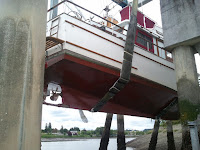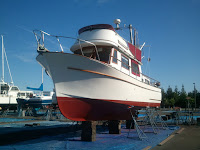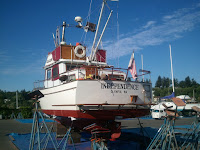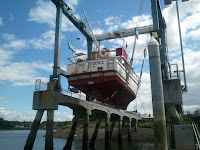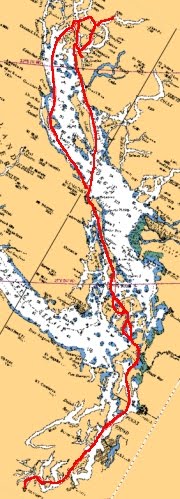August 2, 1995 3093.9
 |
| Boardwalk at Sullivan Bay Marina in 1995 |
Prior to that summer in 1995, I had the fortune to spend some time on the New England coast for business. After work I would venture out to local small eateries - lobster pounds and ocean side cafes - enjoying fresh seafood. While lobster is good, crab is sweeter and more delicate tasting; I fell in love with crab cakes. I set about trying to understand what made New England crab cakes so delicious. I asked - whenever I could - to learn more about crab cake seasonings, ingredients, and recipes.. That summer in 1995 while cruising in beautiful British Columbia waters, I believe I made the perfect crab cakes. I incorporated a lot of the New England flavors that I learned about, but added some of my own twists. The recipe that follows was entered into the MV Independence log that summer and continues to provide my family and friends with great tasting crab cakes. It's got good spice flavor but doesn't overpower the sweet and delicate crab taste, its got lots of crab - not too much stuffing, and some good crunch. These crab cakes always get rave reviews - but of course they've got lots of crab.
It's a new summer with new journeys and time for crab. Enjoy.
When you got plenty of crab try these crab cakes. If you don’t have crab you can substitute a good quality white meat bottom fish. Believe it or not, fish cakes are pretty good too. If you're using fish, lightly poach fish in fresh seawater first.
1 lb. fresh picked crab meat
¼ cup mayonnaise
½ small yellow onion, diced fine
½ T garlic powder
1 T lemon juice
1 t Old Bay seasoning
1 T Dijon mustard
1 T Worcestershire sauce
¾ cup Progresso Italian Bread Crumbs
1 egg
Salt and black pepper to taste
¼ t of Tabasco sauce
2 T olive oil
2 T butter
In a bowl mix crab, mayonnaise, onion, garlic powder, lemon juice, Old Bay seasoning, mustard, Worcestershire sauce, and ¼ cup of bread crumbs. Add egg, salt & pepper, dash or two of Tabasco sauce, and mix well. Form patties about 3-4 inches across and about ½ inch or so thick. Dredge patties through remaining ½ cup of bread crumbs. Lay patties out on a plate or metal pan. Cover and chill or set aside for 30 minutes or so to let the flavors develop.
Heat a heavy skillet with equal portions of butter and olive oil and pan fry patties until lightly browned on each side. Serve with a curry-mayonnaise dip (mix curry powder with mayonnaise to your liking).
 |
| Nice Dungeness crabs aboard the MV Independence |


